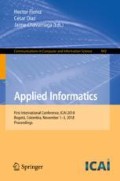Abstract
The design of virtual scenarios and organic models, through the use of virtual reality with the inclusion of photorealism, with all these components can develop a process of handling reactions to phobias that generates an immersive experience similar to reality, obtaining as a result an alternative treatment to arachnophobia, this contribution of help can be partial or total, since it will depend on the time of use. To verify the states of improvement in the users that are submitted to the test of the application, guidelines will be provided to continue the research using a set of technological tools for the area of phobia treatment, as well as the connection of virtual reality in other branches of medicine.
Access this chapter
Tax calculation will be finalised at checkout
Purchases are for personal use only
References
Fendt, M., Fanselow, M.: The neuroanatomical and neurochemical basis of conditioned fear. Neurosci. Biobehav. Rev. 23(5), 743–760 (1999)
Heim, C., Nemeroff, C.: The impact of early adverse experiences on brain systems involved in the pathophysiology of anxiety and affective disorders. Biol. Psychiatry 46(11), 1509–1522 (1999)
Davidson, R., Jackson, D., Kalin, N.: Emotion, plasticity, context, and regulation: perspectives from affective neuroscience. Psychol. Bull. 126(6), 890–909 (2000)
Rothbaum, B., Schwartz, A.: Exposure therapy for posttraumatic stress disorder. Am. J. Psychother. 56(1), 59–75 (2002)
Lange, A., Rietdijk, D., Hudcovicova, M., Van de Ven, J., Schrieken, B., Emmelkamp, P.: Interapy: a controlled randomized trial of the standardized treatment of posttraumatic stress through the internet. J. Consult. Clin. Psychol. 71(5), 901–909 (2003)
Schwartz, J.: Neuroanatomical aspects of cognitive-behavioural therapy response in obsessive-compulsive disorder. An evolving perspective on brain and behaviour. Br. J. Psychiatry Suppl. 35, 38–44 (1998)
Foa, E., Kozak, M.: Emotional processing of fear: exposure to corrective information. Psychol. Bull. 99(1), 20–35 (1986)
Clark, R.: The Safety and efficacy of antivenin Latrodectus mactans. J. Toxicol. Clin. Toxicol. 39(2), 125–127 (2001)
Davey, G.: The disgusting spider: the role of disease and illness in the perpetuation of fear of spiders. Soc. Anim. 2(1), 17–25 (1994)
Kirk, R.E.: Experimental design. In: The Blackwell Encyclopedia of Sociology. American Cancer Society (2015)
Author information
Authors and Affiliations
Corresponding authors
Editor information
Editors and Affiliations
Rights and permissions
Copyright information
© 2018 Springer Nature Switzerland AG
About this paper
Cite this paper
Almeida, J., Suárez, D., Tapia, F., Guerrero, G. (2018). Use of Virtual Reality Using Render Semi-realistic as an Alternative Medium for the Treatment of Phobias. Case Study: Arachnophobia. In: Florez, H., Diaz, C., Chavarriaga, J. (eds) Applied Informatics. ICAI 2018. Communications in Computer and Information Science, vol 942. Springer, Cham. https://doi.org/10.1007/978-3-030-01535-0_11
Download citation
DOI: https://doi.org/10.1007/978-3-030-01535-0_11
Published:
Publisher Name: Springer, Cham
Print ISBN: 978-3-030-01534-3
Online ISBN: 978-3-030-01535-0
eBook Packages: Computer ScienceComputer Science (R0)

